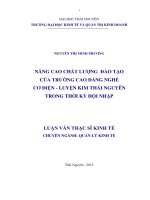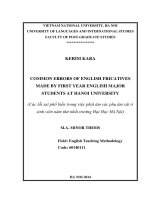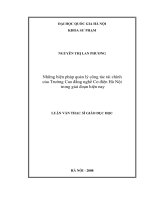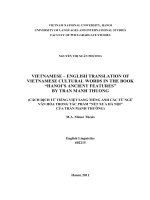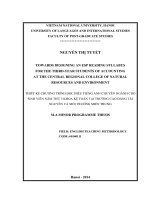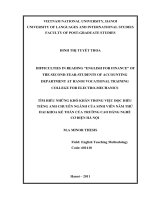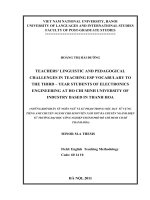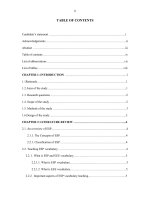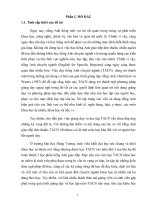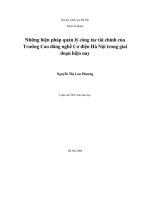Tìm hiểu những khó khăn trong việc đọc hiểu tiếng Anh chuyên ngành của sinh viên năm thứ nhất hai khoa kế toán của trường Cao đẳng Nghề Cơ Điện Hà Nội
Bạn đang xem bản rút gọn của tài liệu. Xem và tải ngay bản đầy đủ của tài liệu tại đây (1.7 MB, 66 trang )
VIETNAM NATIONAL UNIVERSITY, HANOI
UNIVERSITY OF LANGUAGES AND INTERNATIONAL STUDIES
FACULTY OF POST-GRADUATE STUDIES
ĐINH THỊ TUYẾT THOA
difficulties in reading “English for Finance” of
the second-year-students of Accounting
Department at Hanoi Vocational Training
College for Electro-Mechanics
TÌM HIỂU NHỮNG KHÓ KHĂN TRONG VIỆC ĐỌC HIỂU
TIẾNG ANH CHUYÊN NGÀNH CỦA SINH VIÊN NĂM THỨ
HAI KHOA KẾ TOÁN CỦA TRƢỜNG CAO ĐẲNG NGHỀ
CƠ ĐIỆN HÀ NỘI
M.A Minor Thesis
Field: English Teaching Methodology
Code: 601410
Hanoi – 2011
VIETNAM NATIONAL UNIVERSITY, HANOI
UNIVERSITY OF LANGUAGES AND INTERNATIONAL STUDIES
FACULTY OF POST-GRADUATE STUDIES
ĐINH THỊ TUYẾT THOA
difficulties in reading “English for Finance” of
the second-year-students of Accounting
Department at Hanoi Vocational Training
College for Electro-Mechanics
TÌM HIỂU NHỮNG KHÓ KHĂN TRONG VIỆC ĐỌC HIỂU
TIẾNG ANH CHUYÊN NGÀNH CỦA SINH VIÊN NĂM THỨ
HAI KHOA KẾ TOÁN CỦA TRƢỜNG CAO ĐẲNG NGHỀ
CƠ ĐIỆN HÀ NỘI
M.A Minor Thesis
Field: English Teaching Methodology
Code: 601410
Supervisor: Dr. Dƣơng Thị Nụ
Hanoi – 2011
iv
List of abbreviation
ESP: English for Specific Purposes
EOP: English for Occupational Purposes
EAP: English for Academic Purposes
EEP: English for Educational Purposes
GE: General English
IT: Information Technology
HVTCEM: Hanoi Vocational Training College for Electro-Mechanics
v
List of figures, charts and tables
Figures:
Figure 1: ESP classification by experience
Figure 2: ESP classification by professional area
Tables:
Table 1: Students’ perception on the purposes of learning reading English for Finance
Table 2: Students’ focus when learning English for Finance
Table 3: The difficulties in term of reading skills
Table 4: The difficulties in term of vocabulary
Table 5: The difficulties in term of grammar
Table 6: The difficulties in term of cultural background knowledge
Table 7: Students’ views of sources of difficulties
Table 8: The students’ expectation in term of materials
Table 9: The students’ expectation in term of methodology
Charts:
Chart 1: Students’ preference in ESP reading
Chart 2: Students’ perception on the importance of ESP reading
Chart 3: Students’ perception on the necessity of reading English for Finance for their future job
vi
TABLE OF CONTENTS
Statement of authorship
Acknowledgement
Abstract
List of abbreviations
List of figures, tables and charts
Table of content
i
ii
iii
iv
v
vi
Part I. INTRODUCTION……………………………………………………….
1. Rationale
2. Aims of the study
3. Research questions
4. Methods of research
5. Scope of the study
6. Organizations of the study
1
1
1
2
2
2
2
Part 2: Development ………………………………
Chapter 1: Literature review
4
4
1.1. Basic concepts about ESP……………………… ………………….
1.1.1. Definitions of ESP
1.1.2. Types of ESP
1.2. Reading in ESP teaching and learning
1.2.1. Reading skills in ESP
1.2.2. ESP teachers and their roles
1.2.3. ESP students and their roles
1.2.4. ESP reading materials and their roles
1.3. Difficulties in ESP reading
1.3.1. Reading skill problem
1.3.2. Language problem
1.3.3. Cultural background knowledge problem
4
4
5
6
6
6
7
7
8
8
9
9
vii
1.4. Summary
10
Chapter 2: The current situation of teaching and
learning English for Finance at Hanoi Vocational
Training College for Electro-Mechanics
2.1. Institution
2.2. The teachers and their methods of teaching
2.3. The students and their background knowledge
2.4. The teaching and learning English at HNVTCEM
2.5. General review of the course book “English for Finance”
2.5.1. Rationale for choosing the course book and objectives of the course
2.5.2. Topics, terminologies and grammatical structures
2.5.3. Characteristics of reading texts
2.6. Summary
11
11
11
12
12
13
13
14
16
17
Chapter 3: Research Methodology
3.1. Participants
3.2. The data collection methods
3.3. The data collection procedure
3.4. Data analysis
3.5. Summary
18
18
18
19
20
20
Chapter 4: Findings and discussion
4.1. Discussion of the results collected by means of the questionnaire
4.1.1. Students’ attitude towards ESP reading
4.1.2. Students’ perception on the purposes of reading lessons
4.1.3. Students’ focus when learning English for Finance
4.1.4. Students’ difficulties in learning reading English for Finance
4.1.4.1. In term of reading skills
4.1.4 2. In term of vocabulary
4.1.4 3. In term of grammar
21
21
21
22
23
23
24
24
25
viii
4.1.4 4. In term of cultural background knowledge
4.1.5. The causes for these difficulties in learning reading English for Finance
4.1.5.1. From the reading materials
4.1.5.2. From the teachers
4.1.5.3. From the learners
4.1.6. The learners’ expectation in term of materials
4.1.7. The learners’ expectation in term of methodology
4.2. Discussion of the result collected by means of the interview, classroom
observation and journal keeping
4.2.1. Teachers’ attitude towards ESP reading
4.2.2. Teachers’ opinion on the course book they are teaching
4.2.3. Teachers’ focus when teaching reading English for Finance
4.2.4. Teachers’ techniques to teach students in reading English for Finance
4.2.5. Teachers’ difficulties in teaching reading English for Finance
4.2.5.1. In term of cultural background knowledge
4.2.5.2. In term of methodology
4.3. Summary
27
27
27
27
28
30
31
32
32
33
33
33
34
34
35
36
Chapter five: Recommendations
5.1. Training students to become efficient readers
5.1.1 Improving students with different reading strategies
5.1.2 Encouraging students to develop extensive reading habits
5.2. Improving teachers’ techniques in teaching English for Finance
5.3. Developing English for Finance reading materials
5.4. Improving teachers’ professional knowledge about economics
5.5. Improving teachers’ teaching methodology
5.6. Summary
37
37
37
38
39
40
40
41
41
ix
Part 3: CONCLUSION…………………………………………………………
1. Summary of the findings
2. Limitation of the study and suggestion for further study
42
42
43
REFERENCEs………………… ……………………………………………
Appendices ……………… ……………………………………………
Appendix 1: Phiếu điều tra nghiên cứu
Appendix 2: Interview questions for teachers
Appendix 3: List of topics in the course book
Appendix 4: Unit 17: Financial statements
Appendix 5: Translated version of the survey questionnaire for students
44
I
V
VI
VII
IX
1
Part 1: Introduction
1. Rationale
Learning English now is not only an interest but also a practical thing for many people.
Learning English means learning four related skills: listening, speaking, reading and writing. In
teaching and learning English as a foreign language in Vietnam, reading has always received a
great deal of attention. This is understandable because English is taught and learnt in non-English
environment, so reading is not only the important means to get knowledge but also means of
further study. What is more, by means of English, the learners can take it professionally in their
future work as well as in reading their specialized materials. It is exactly true for students of
accounting.
At Hanoi Vocational Training College for Electro-Mechanics (HVTCEM), after finishing
120 general English periods, students of accounting department begin to take 60 ESP periods.
Being an ESP teacher of economics, the researcher has always been aware of the importance of
developing reading skill for accounting students. If students read well, they are able to handle
subject-related written materials in English and to work with modern technology equipment. But
in fact, in spite of the effort of the teachers and students, the researcher finds her students‟
reading disappointing, which do not meet the requirements of the college. It is often seen that
when poor reading results are reported, one tends to blame the students for having poor ability or
for making insufficient effort. However, the students are not always at fault. With some years of
English teaching experience, the researcher recognized that there are many other factors that
affect the teaching and learning reading process such as inappropriate teaching methods and
classroom techniques, inappropriate attitude of the teachers and learners towards the subjects,
unsuitable teaching materials, etc.
For all the above reasons, the researcher would like to find out the areas of students‟
difficulties at HVTCEM when learning reading English for Finance and the cause of these
difficulties. It is also hoped that the study will make some suggestions for the teachers and
learners to improve the teaching and learning English for Finance at college.
2. Aims of the study
This study aims to investigate the difficulties in reading English for Finance of the second
year students at HVTCEM. To be more specific, the objectives of this study are:
2
- To investigate the present situation of teaching and learning reading English for Finance
so as to find out the teachers and learners‟ areas of difficulties when teaching and learning
English for Finance.
- To suggest the ways to reduce these difficulties and help learners to improve their ESP
reading skills.
It is hoped that the findings from this study will be some benefits to teachers and students
at HVTCEM.
3. Research questions
In order to achieve the aims mentioned above, two research questions were raised:
- What are the teachers and learners‟ areas of difficulties when teaching and learning
reading English for Finance?
- To what extent do the teachers‟ teaching methods help learners overcome the difficulties
and improve their ESP reading skills?
4. Methods of research
With the aims of finding out the areas of the difficulties in reading English for Finance at
HVTCEM, this study adopts a survey research. To achieve this aim, the survey questionnaire is
used as the main instrument to collect the needed data from the learners. Besides, other
instruments are also made used of such as the researcher‟s observation, journal keeping as well as
interview questions with the other 6 teachers of the College.
5. Scope of the study
The study mainly focuses on some difficulties in ESP reading experienced by the second
year students of Accounting at HVTCEM, and then suggests some techniques to help them
overcome these difficulties and to improve their ESP reading skill.
6. Organization of the study
This study consists of three main parts: Introduction, Development and Conclusion.
The first part includes the rationale for choosing the topic of the study, the aims, the research
questions, the methods, and the scope of the study.
The second part comprises five chapters. Chapter one deals with the theoretical background
relevant to the research topic including Basic concepts about ESP, reading in ESP teaching and
learning, difficulties in ESP reading. Chapter two discusses the current situation of teaching and
learning English for Finance at HVTCEM. Chapter three presents the research methodology,
3
which focuses on the participants, the data collection methods, the data collection procedure and
the data analysis. Chapter four presents findings and discussion. Chapter five provides some
recommendations to reduce difficulties in reading English for Finance.
The last part summarizes the mains issues of the study, points out the limitations and presents
some suggestions for further research.
4
Part 2: Development
Chapter 1: Literature review
1.1. Basic concept about ESP
1.1.1. Definitions of ESP
There are different definitions of ESP by different linguists. According to Hutchinson and
Waters (1987), “ESP-an approach not a product- does not involve a particular kind of language,
teaching materials or methodology”. In their opinion, ESP is not a matter of teaching specialized
varieties, but “is an approach to language in which all decisions as to content and method are
based on the learners’ reason for learning”. So an ESP course should differ from a general
English course in selection of skills, themes, topics, situation and function. And, all ESP courses
should be based on the learners‟ needs and meet the learners‟ needs.
However, Strevens‟ definition of ESP (1988) makes a distinction between 4 absolute
characteristics and two variable characteristics:
- The absolute characteristics of ESP are:
+ designed to meet specified needs of the learners
+ related in context (that is in its themes and topics) to particular disciplines, occupations
and activities.
+ centered on language appropriate to those activities in syntax, lexis, discourse,
semantics, and so on, and analysis of the discourse.
- The variable characteristics are that ESP:
+ may be restricted to skill to be cleaned (for example reading only)
+ may not be taught according to any pre-ordained methodology.
The definition by Robinson is based on two key defining criteria and a number of
characteristics that are found to be true of ESP. The key criteria are that ESP is “normally goal-
directed” and that ESP courses develop from a need analysis, which “aims to specify as closed as
possible what exactly it is that students have to do through the medium of English” (Robinson,
1991:3).
From the definitions above, it is clear that ESP courses are purposeful and aimed at the
successful performance of occupational roles by an individual or a group whose need is
considered to be a distinguished feature to those of General English.
5
1.1.2. Types of ESP
ESP has been classified into different types, but the major distinction is often drawn
between the two main areas namely EOP (English for Occupational Purposes) and EAP (English
for Academic Purposes)/ EEP (English for Educational Purposes). The former involves work-
related needs and training while the latter involves academic study. Following is Robinson‟s tree
diagram, which indicates a distinction between these two areas.
ESP
Figure 1: ESP classification by experience (Robinson, 1991: 3)
Another diagram is used by Dudley-Evans and Jo St John (1998) to subdivide ESP. In this
diagram, ESP is also divided into two main areas: EAP and EOP, but they are further divided in
terms of discipline or professional area.
Figure 2: ESP classification by professional area (Evans and St John, 1998:6)
EOP
EEP/EAP
Pre-experience
Simultaneous/ In-service
Post-experience
For a study in a
specific discipline
As a school subject
Pre-study
In-study
Post-study
Independent
Integrated
English for Specific Purposes
English for Academic Purposes
English for Occupational Purposes
English for
(Academic)
Science and
Technology
English for
(Academic)
Medical
Purposes
English for
(Academic)
Legal
Purposes
English for
Management
Finance and
Economics
English for
Professional
Purposes
English for
Vocational
Purposes
English
for
Medical
Purposes
English
for
Business
Purposes
Pre-vocational
English
Vocational
English
6
1.2. Reading in ESP teaching and learning
1.2.1. Reading skills in ESP
In case of reading skills in ESP, Dudley-Evans and Jo St John (1998:96) listed the keys
skills to be learnt and transferred into a new language as follows:
selecting what is relevant to the current purpose; using all the features of the text such as
headings, layouts, type face; skimming for content and meaning; scanning for specifics;
identifying for organizational patterns; understanding relations within a sentence and between
sentences; using cohesive and discourse markers; predicting, interfering and guessing;
identifying main ideas, supporting ideas and examples; processing and evaluating the
information during reading; transferring or using the information while or after reading.
Although ESP reading is usually related to particular content areas such as technology or
engineering, the recent trends in ESP seem to share the assumption that readers‟ strategies can be
generalized across subject boundaries. This means general reading strategies should be taught to
ESP students because, as Hutchinson & Waters (1987) pointed out, ESP is not different in kind
from any other form of language teaching and ESP teaching should be based on the principles of
effective and efficient learning.
1.2.2. ESP teachers and their roles
Almost ESP teachers are teachers of General English (GE) who have unexpectedly found
themselves required to teach English for a specific purpose. They are just “new settlers in a new
land” (Hutchinson and Waters, 1986) with no agreed maps to guide them. For the non-native
teachers of English, they may have undoubtedly competence in English, but they may not cope
with students‟ areas of specialism. Therefore, unlike a GE teacher, an ESP teacher is required to
have both competence in English and the knowledge of the students‟ specialist area. In addition
to the normal functions of a classroom teacher, “the ESP teacher will have to deal with needs
analysis, syllabus design, materials writing or adaptation and evaluation” (Hutchinson and
Waters, 1987:157). Also according to these authors, ESP teachers should have three factors: (1) a
positive attitude towards the ESP content; (2) knowledge of the fundamental principles of the
subject matter; (3) an awareness of how much they probably know.
Concerning to the roles of ESP teachers, Littlewood (1981:51) stated the ESP teacher is
expected to “perform in a variety of roles, separately or simultaneously”. In fact, the role of the
7
teacher will vary according to the type of syllabus and course, the teaching and learning
environment (Jordan, 1997). Thus, one of the most important qualities that an ESP teacher
expects to have is flexibility which helps him to change from being a general language teacher to
being a specific purpose teacher, and to cope with different group of students at a very short
notice.
According to Dudley-Evans and Jo St John (1998), the ESP teacher acts as a teacher, a
course designer and material provider, a collaborator, a researcher and an evaluator.
From those points of view, an ESP teacher must fulfill these widely acknowledged roles.
And as the teaching becomes more specific and challenging, it is necessary that “ESP teacher
must know something about the subject matters of ESP materials” (Hutchinson and Waters,
1987:161)
1.2.3. ESP students and their roles
Students come to an English reading class with different command of English and for
different purposes, but in any reading classes, the students act as readers. They are involved
actively in getting the right meaning from the text. Sometimes, they meet difficulties in
interpreting the text because of unfamiliar vocabularies and limited background knowledge or
because their speech and comprehension ability are not yet up to the expectation. In this case, the
students have to work in the direction of their teachers. Besides, ESP students also have to
become familiar with English used in their specialized field. Having acquired basic English in
terms of grammar and having been familiar with reading activities, these students attend ESP
reading classes with the hope to improve their reading skills in their specialized field.
Furthermore, in reading, the students would solve texts which are full of terminologies that can
be comprehensively understood only in combination with their available specialized knowledge.
In short, for vocational purposes, ESP students are in a more requirement of not only English
knowledge but also specialized knowledge of the field.
1.2.4. ESP reading materials and their roles
Materials are very important in teaching and learning process, especially in teaching ESP.
They are considered as a source of language and a learning support. They are also used for
motivation and stimulation and for reference. ESP is designed to meet specific needs of the
learners so selecting reading materials is very necessary. Selecting materials involves making
8
choices and decision. To make good choices, we need to have good criteria on which to base the
decision. These criteria such as factors about the learners, the role of materials, the topics, the
language, the presentation have been put forward for the analysis of materials and each of them
has validity. A good ESP material must contain interesting texts and enjoyable activities which
make students think, opportunities for them to use their existing knowledge, skill and content that
they and their teacher can cope with; truly reflect what they think and feel about learning process;
provide clear and coherent unit structure to guide the students through various activities to
maximize the chances of learning; introduce teachers to a new techniques and provide models of
correct and appropriate language use (Hutchinson and Waters 1987; 107).
1.3. Difficulties in ESP reading
Reading in a foreign language is important to personal development, professional success
and academic studies. However, in learning reading especially in ESP reading, there are many
factors affecting reading success such as reader‟s reading habits, attitude, motivation, exposure to
the target language, textual characteristics, the way reading is taught and the teacher‟s classroom
techniques or learning environment, etc. The previous studies by Jolly (1978), Coady (1979),
Yorio (1971) and others indicate that problems with foreign language reading may lie either on
learners‟ reading skills, language proficiency or cultural and background knowledge.
1.3.1. Reading skill problems
According to Jolly (1978), one‟s first language reading ability plays a more important role
in reading success than his level of the target language does because foreign language reading
requires the transference of old skills, not the learning of new ones. This view is shared by Coady
(1979) who confirms that foreign language reading is a reading skill problem, not a language
problem.
Bernhard (1985:17) stated “Reading performance in a second language is largely shared
with reading ability in a first language”. Sharing the same view, Sarig, G (1987) assumed that
“the same reading strategies types accounted for success and failure in both languages to almost
the same extent. It can be concluded, then, that reading processes from the first language appear
to transfer to the foreign language”.
It can be seen clearly that students‟ limited reading skills create many problems such as
reading slowly, failing to understand and summarize main ideas of the reading text, and to enable
9
to guess or predict meaning of the words or phrases used in that context, etc. Therefore, such
students find it hard to be successful in their reading. Finally, learners‟ motivation towards reading
is also an important factor in reading process. It may affect reading result such as good speed,
enjoyment, and comprehension. Lacking motivation, the readers do not want to keep on reading.
1.3.2. Language problems
Problems of foreign language learners in reading process, according to Yorio (1971:108),
are mainly caused by the imperfect knowledge of the target language and the interference of the
native language. In his view, reading involves four factors: knowledge of the language, ability to
predict or guess in order to make the correct choice, ability to remember the previous cues, and
ability to make the necessary associations between the different cues that have been selected.
Therefore, learners with limited knowledge of the target language might have considerable
difficulty in reading in the target language. This view is supported by other researchers
(Alderson, 1984, and Clarke (1980) who acknowledged that a lack of appropriate linguistic
knowledge prevents the transfer of reading skills and strategies from the first language to the
second language.
When readers deal with a reading text, the first problem they often face is that they may
have to work with unfamiliar and difficult topics. These are called “text problems”. The content
of the text is rather strange to students, which makes them unable to understand. Besides, another
kind of problem is “vocabulary problems”. As we know grammatical knowledge accounts for a
great deal of competence in reading. However, knowledge of grammar is a great deal more
important as a factor of reading comprehension than awareness of grammatical structures
(O‟Donnel, 1961:313-316). Readers encounter a lot of difficulties in dealing with probers and
idioms, synonyms, antonyms, metaphor, etc which can be considered to have an impact on the
readers‟ motivation. These are the difficulties that foreign learners often face with when reading.
ESP students also have other difficulties in dealing with terminologies, concepts, tables, charts,
graphs in their specific field. All the above mentioned difficulties interfere with their process of
learning reading ESP and set challenges for ESP and, therefore, make the teachers try to find out
the ways to help their students with these.
1.3.3. Cultural background knowledge problems
10
Apart from language problems and reading skills problems, cultural background
knowledge can also affect students‟ reading ability. Studies by Steffensen et all. (1979); Carrell
(1981) illustrated the effect of cultural knowledge on the product of comprehension, appealing to
the processes of distortion and elaboration to account for the differences between a recall of a text
and the original text. Readers facing with unfamiliar cultural content may mistranslate or
misinterpret the text according to their own cultural experiences. It can also be seen that the
cultural origin of a text has greater effect on comprehension than syntactic or semantic
complexity of the text.
For text structures, the impact of culture is less outwardly evident but apparently still
present. They will greatly affect readers‟ comprehension. Sometimes, the implicit cultural
knowledge presupposed by a text or from different assumption about meaning and
comprehension held by the writer also causes difficulties to the readers. For students of
Accounting, although accounting rules or knowledge of economics are international applied, the
presentation of accounting and economic texts may vary according to different countries that
make students confused and misinterpret the reading texts.
From what we have discussed, it can be concluded that there are three main factors that
affect reading comprehension: reading ability or reading skills; language proficiency or language
knowledge; and cultural and background knowledge. Reading difficulties may be related to
number of other factors such as readers‟ reading habits, attitude, motivation, and exposure to the
target language, textual characteristics or the learning environment. Whatever kind the problems
are, they are various in the reading process in a foreign language and great efforts must be made
to overcome them.
1.4. Summary
In this chapter, the relevant literature which has helped to form the theoretical and
conceptual framework for the present study is presented. First, it provides basic concept about
ESP in which definitions, types of ESP are taken into consideration. Next, information of reading
skills in ESP and factors in teaching and learning are discussed. Those factors include ESP
teachers, ESP students, and ESP materials and their roles. Finally, it presents an insight into ESP
reading difficulties, which include reading skill problems, language problems, and cultural
background problems.
11
Chapter two: The current situation of teaching and learning
English for Finance at Hanoi Vocational Training College for
Electro-Mechanics
2.1. Institution
HVTCEM was founded in 1972. Initially, it was only a Vocational School. Gradually, it
was upgraded and became a Vocational Training College for Electro-Mechanics in 2006. Now,
its mission is to train students to become workers in the major fields of Mechanical Engineering,
Mechanical Dynamic Engineering, Electrical and Electronics Engineering, Automobile and
Welding Trade, and accountants and IT technicians in two new fields: Accounting and
Information Technology.
The students are provided with a lot of general educated subjects and different
specializations like other institutions, of which English has been regarded as a vital component in
the program. But in fact, the conditions for teaching and learning English are not ideal due to the
large class-size (more than 60 students in total), non-language environment, out-of-date reference
documents, lack of facilities for language learning and teaching such as videos, tape recorders,
projectors, and so on.
2.2. The teachers and their methods of teaching
There are 12 teachers of English at the HVTCEM, aged from 26 to 41. All of the teachers
are female and have university diploma from different universities in Vietnam. At present, one of
them is a M.A., the other 6 are doing a M.A. course. They are all teachers of GE who were not
trained to teach ESP and they do not have knowledge of economics, either. In fact, the teachers
who were appointed to teach English for Finance hesitated to accept their task because it did take
time for them to become familiar with the ESP course material. However, when being in charge
of an ESP class, they are energetic and willing to devote their time and energy to teaching. The
problem is that they are inexperienced in teaching ESP and they also have no specialist
knowledge on the subject matter. So, they have to face many difficulties, of which the lack of the
professional knowledge and the choice of appropriate teaching methodologies seem to be the
major concerns. What is more, most of them have little chance to access to the latest alterations
of language teaching methods. Therefore, the majority of them still adopted the traditional
12
method of teaching in ESP reading lessons, which emphasizes translation activities, learner
conformity in task completion, and success in an examination format. Students are passive and
only ask the teachers when they encounter difficult structures or words that they cannot find in
the dictionary. And the success is based on how flexible and adaptable the individual teacher is to
respond to the requirement of the new teaching situation.
2.3. The students and their background knowledge
The students of Accounting Department at the HVTCEM are full-time students, aging
from 18-25 so they belonged to the same psychological age group. They come from different
parts of the country. Most of them are from the rural or remote areas, where there are no good
opportunities for studying English so they are varied in terms of English proficiency. The others,
who come from cities, theoretically, have all finished three years or seven years of learning
English at high schools before entering the college, but in fact, their levels are rather mixed.
To some extent, there are some students whose English is very good, but generally the
target students‟ English proficiency is still of low level. Moreover, the students come to the class
with different English background and different attitude, motivation, learning style towards
learning the language. Some have learnt the Basic English at school, some have learnt Russian or
French and the others have never learnt a foreign language. Thus, the first thing the teachers have
to do is to improve the students‟ level of GE before they can deal with subject matters in this
language. In addition, although they had learnt the subjects of economics in Vietnamese, their
specialized knowledge is rather poor so they find it difficult to read texts of economics in
English. Another issue is that most of the students do not have the habit of learning
independently and tend to depend on the textbooks and the teachers for knowledge. Finally, the
large class size also makes the teachers and students difficult to fulfill their task of teaching and
learning.
2.4. The teaching and learning English at Hanoi Vocational Training College for Electro-
Mechanics
Due to the particular tasks of our Vocational Training College, English at HVTCEM is
allowed to be non-major subject. Like many other subjects, English is taught in a formal
classroom without language environment and the students have to do two English courses: 120-
period GE and 60-period ESP, one after another.
13
As far as the teaching materials are concerned, some textbooks for GE such as
“Streamline (Departure)”, “New Headway (Elementary)” and “New Cutting Edge (Elementary)”
have been used recently. In the stage for GE, the main objectives are to provide students with
basic communicative skills. Thus, the four language skills (listening, speaking, reading and
writing) are focused on. At the end of this term, students have to sit for a written exam which
includes mainly grammar and vocabulary exercises.
In the stage for ESP, the course books at HVTCEM include “English for Automobile and
Welding Trade”, “English for Electrical and Electronics Engineering”, “English for Finance”
and “English for Computer Science”, which were compiled by the teachers of Basic Science
Department of College. The ESP textbooks were designed with the purposes of providing the
students with an amount of vocabulary relating to the investigation topics and training reading
skills which would be helpful for their future job. They focus on language skills: reading, writing,
and translation. The ESP textbooks put greater emphasis on content teaching – the knowledge of
the specific areas than that on the language skills. However, for most of the students learning
these ESP textbooks, reading is the most challenging task.
In term of methodology, ESP teachers usually employ the traditional method of teaching.
They often play the key role in the lesson, being the main speaker whereas the students are
passive, only asking the teachers when the come across with difficult structures and vocabulary.
2.5. General review of the course book “English for Finance”
2.5.1. Rationale for choosing the course book and objectives of the course
As can be seen, materials can be classified into textbooks and in-house materials. The
textbooks have been officially published and are available in the markets. Teachers can choose
them to teach students because these textbooks are written by the experts who have a lot of
experience and expertise in the field and they will obviously be useful for the students.
Nevertheless, they are often criticized for not satisfying students‟ specific needs. On the contrary,
in-house materials which are compiled by the ESP teachers in the college or University used
locally can make for the drawbacks of the published books. Robinson, (1991: 58) believed that
in-house materials are likely to be more specific and appropriate than published materials and
therefore have greater benefits. Moreover they are more flexible than published materials because
the writers of in-house materials understand well the situation of teaching ESP to their students.
14
For all above reasons, the book “English for Finance” has been chosen to be the official
course book for students of Accounting. The book was written by Cao Xuan Thieu (Dean) and
the teachers of Languages Department at Financial Academy, and first published in 2006. It was
compiled mainly based on course book sources, books and references of some countries like
Britain, America, Canada, Australia and so on in the fields of Economics, Finance, Banks, Taxes,
Accounting, Marketing, etc.
The book was written with the aim of providing specialized knowledge of economics for
different kinds of learners: those who have never learnt Economics, those who prepare for their
future job, and those who have ever learnt Economics and now want to improve their
professional knowledge to adapt their study and future job requirement.
As a result, by the end of the English for Finance course, students will be able to:
- Develop reading skills and strategies
- Enlarge their economic vocabulary and terms in English
- Master English terms for economics used in different kinds of documents
- Consolidate and enhance basic grammatical structures used in specific texts
- Translate economic materials from English into Vietnamese and vice versa better
With such objectives of an ESP course for economics, students can build up a sense of self-
confidence when contacting different economic materials in English to get the most general ideas
of the materials and serve their future study and career. Students are also expected to obtain
useful skills for different types of reading texts so as to understand authentic and adapted texts of
economics, professional English materials.
2.5.2. Topics, terminologies and grammatical structures
The book consists of 25 units covering 25 topics with reading focus only. Each unit
discusses one basic issue closely related to economics such as The economic organization of
society, Supply and Demand together, Pricing policies, Inflation, etc; related to accounting such
as Accounting, Financial statements, Assets, Liabilities, Depreciation, Audits, etc or related to
finance like Public finance and business finance, Corporate finance (Please refer to Appendix 3).
Each unit was arranged into five parts. The first is Reading text. The second and most
important one is Comprehension questions. The third part is Language focus. The fourth one is
Word study which includes some kinds of exercises like gap filling, multiple choice, true/false,
15
and matching definition. The last one is Vocabulary. Each unit has different length depending on
the complexity of the subject matter. In every unit, concrete objectives are set up at the
beginning. For example, the objectives of Unit 17 “Financial statements” on page 94 (Please
refer to Appendix 4) state that at the end of the lesson, students should be able to:
- Distinguish the three financial statements
- Improve reading skills: scanning for details and skimming for main ideas
- Be more confident, active and co- operative
Concerning Terms in the reading texts, they can be classified into two main groups
according to their structural patterns: single and compound terms.
Single terms are made up of one word, usually a noun or a verb such as inflation (lạm
phát), finance (tài chính), accounting (hạch toán kế toán), liabilities (tài sản nợ), depreciation
(khấu hao), ect, whearas the compound terms consists of two or more words. These words, which
are of different parts of speech, combine together and create terms that have the form of nominal
groups such as public finance (tài chính công), business finance (tài chính doanh nghiệp), direct
taxes (thuế trực thu), indirect taxes (thuế gián thu), capital market (thị trường vốn), financial
statements (các bản báo cáo tài chính), fixed assets (tài sản cố định), etc.
In addition, the terms exist in various forms. They may be written in full such as “over-
the-counter transactions” or using acronyms (initial letters of words that form a group of words)
such as OTC transactions (over-the-counter transactions), ECR (Exchange Control Regulations),
GAAP (Generally accepted accounting principles), VAT (Value added Tax), etc. One term may
be repeated several times in each text. For example, “The end product of the financial accounting
process is a set of reports that are called Financial statements. GAAP require that such three
reports be prepared: (1) a balance sheet, (2) an income statement, (3) a statement of cash flow”
(Unit 17, page 94).
Examining the grammatical structures of the texts, it is necessary to cover three sub-
units such as words, sentences and tenses. Normally, an English word may consist of three parts:
a prefix, a stem and a suffix. Most of the words in the course book exist in the form of stem
(finance, balance, interest, revenue ), some use prefix (inflow, outflow, inputs, outputs,
imperfect ) or suffix (shortage, allowance, cashiering, profitable, negotiable ). Furthermore,
taking a closer look at sentences in the reading texts, it can be seen that simple and complex
16
sentences are used regularly. In some texts, complex sentences are used more often than the
simple ones. The use of these sentences with which/that clause is important in content
development as it helps in giving definitions or explanations or referring back to what is
mentioned. For example, “There are roughly three ways to do it. First it is setting interest rate
ceilings and floors, which means limiting, upwards or downwards, the fluctuations of the interest
rate The third one which is a bit more modern is those open-market operations, which are
simply buying and selling government bonds to and from commercial banks” (Unit 11, page 63).
In addition, the sentences are presented in both active and passive voice. The passive sentences in
some texts outnumber the active ones such as “Planned economy: A system whereby the structure
of the market is deliberately planned by the state, in which production and consumption quotas
are fixed beforehand ” (Unit 2, page 12).
In term of tenses, verbs in this book are limited to present simple, present perfect, or simple
future as the contents of most units share the same feature as to introduce to the readers and
students the true knowledge related to economics in present or future. For example, “Inflation is
an economic condition in which prices for consumer goods increase and the value of money or
purchasing power decreases” (Unit 6, page 37).
2.5.3. Characteristics of reading texts
The organization of information in reading texts of this course book, on one hand, shares
common characteristics of other reading texts, on the other hand, has its own characteristics. The
information is grouped into themes, in each of which there is the explanation of the main idea,
terms, definition, examples for illustration, and the summary of the main ideas. The information
is organized in either deductive or inductive way. However, it should be noted that economics
consists of some other fields such as accounting, finance so examples used to explain are rather
important. Normally, thanks to examples, readers can understand the explanation of the main
ideas thoroughly and can guess the meaning of the whole text.
The summary of a sample unit, which characterizes the reading text of accounting: Unit
17 on page 94: Financial statements (Please refer to appendix 4).
The content of this unit covers financial statements (or a set of reports) so the first
paragraph is about the presentation of three kinds of financial reports and the second paragraph is
the explanation of these reports in details. It can be said that the organization of information in
17
the reading text is very clear; explanation of the main idea is careful including examples to
illustrate. Nevertheless, the explanation of the main idea sometimes makes readers confused and
difficult to understand because of the vocabulary, terms or sentence structures or even difficult
specialized knowledge.
In short, after having a look at a general review of the course book “English for Finance”
and introduction of some typical features of the reading texts, the researcher hopes to improve the
teaching and learning English for finance in the way that it will help ESP teachers to be aware of
the complicated nature of economic reading texts so that suitable strategies to teach reading will
be applied to minimize the reading problems and to improve students‟ reading skills.
2.6. Summary
This chapter has provided an overview of the current situation of teaching and learning
English for Finance at Hanoi Vocational Training College for Electro-Mechanics, given some
information about the institution, the teachers and their methods of teaching, the students and
their background knowledge. The researcher has also presented general review of the course
book “English for Finance” and objectives of the course. Some problems that the teachers and
students at the College face in the teaching and learning of ESP reading were pointed out.
